Editorial: Are later school start times really what's best?
State Rep. Jill Cooper wants to introduce legislation that would set a minimum start time for Pennsylvania schools. The idea is grounded in science. There is plenty of research that advocates for more sleep for children, particularly high school students.
“There is a consensus in the medical community that a public health crisis exists in the form of an epidemic of chronic sleep loss and daytime sleepiness in adolescents,” Cooper, R-Murrysville, wrote in her memorandum seeking cosponsors.
The idea would be to take back some of the control school districts have over start times, saying school couldn’t start before 8:15 a.m. It sounds completely reasonable and no doubt well intentioned.
But aside from the slippery-slope argument of nibbling away at the autonomy of districts, there is the question of what else it would impact.
Moving start times means moving bus times, which means moving when kids are at bus stops. That could affect whether districts can re-use buses for two rounds of transportation for elementary and secondary students. Would that move one start time to 9 a.m. or later? Would it impact what districts had to pay for busing? Would it make it harder to get already-difficult-to-find drivers?
Would it really get kids more sleep if pushing school starts also pushed after-school activities like sports and extracurriculars later in the afternoon and into the evening? What about homework? Would it mean less family time?
Speaking of families, would it negatively affect working parents who might need to leave for work sooner? Would that lead to dangers of young children being left alone at bus stops, particularly when it’s cold and dark? Would it increase truancy for older students left to their own devices and opting to “miss” the bus?
Other states, such as California and Florida, have played with this idea. Others are considering it, including Pennsylvania neighbors New Jersey and New York. But the National Education Association has seen mixed reactions to questions about it, and a University of Minnesota study showed low academic return in some places where it has been implemented.
This isn’t to say Cooper is wrong in pursuing change or challenging the status quo. It’s just that pursuing a good idea can be a bit like the butterfly effect. Change one thing here and create unintended consequences elsewhere.
Remove the ads from your TribLIVE reading experience but still support the journalists who create the content with TribLIVE Ad-Free.

